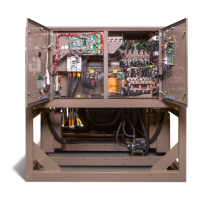JOHNSON CONTROLS
23
Form 201.47-ICOM1
Issue date: 17/11/2022
3
Section 3 - Rigging, handling, and storage
Lifting weights
Refer to the unit nameplate for unit shipping weight.
Note that weight may vary depending on unit configu-
ration at the time of lifting. See Table 5 on page 66
or Table 6 on page 70 for further information regard-
ing shipping and operating weights.
Delivery and storage
To ensure consistent quality and maximum reliability,
all units are tested and inspected before leaving the
factory. Units are shipped completely assembled
and containing refrigerant under pressure. Units are
shipped without export crating unless crating has been
specified on the Sales Order.
If the unit is to be put into storage, before installation,
the following precautions must be observed:
• The chiller must be blocked so that the base is not
permitted to sag or bow.
• Ensure that all openings, such as water connec-
tions, are securely capped.
• Do not store where exposed to high ambient air
temperatures that may exceed relief valve set-
tings. Refer to Long-Term Storage Requirement
- Field Preparation (Form 50.20-NM7).
• The condensers must be covered to protect the coils
-
ticularly where building work is in progress.
• The unit should be stored in a location where there
is minimal activity in order to limit the risk of ac-
cidental physical damage.
• To prevent inadvertent operation of the pressure
relief devices the unit must not be steam cleaned.
• Inspect the unit periodically during storage.
Rigging and lifting must only be done by a professional rigger in accordance with a written
rigging and lifting plan. The most appropriate rigging and lifting method will depend on job specic
factors, such as the rigging equipment available and site needs. Therefore, a professional rigger
must determine the rigging and lifting method to be used, and it is beyond the scope of this manual
to specify rigging and lifting details.
LD19197

